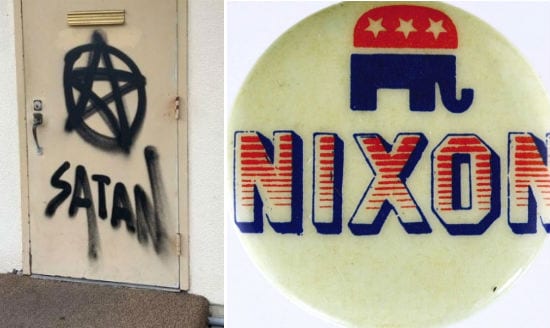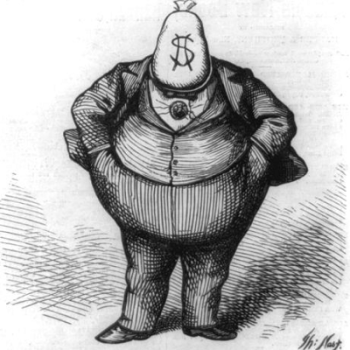• “Promise Rings and Immigrant ‘Invasions’: How Evangelical Purity Culture Helps Explain Trumpism.”
“On its face, evangelical purity culture and American racism overlap only insofar as white people are the dominant participants in both,” Jill Filipovic wrote last month for Vanity Fair. Then she goes on to reflect, thoughtfully, how both of these relate to a fearful, defensive approach to the world.
I appreciate Filipovic’s insights here — it’s a smart essay. But these two things — the racism that drives Trump and replacing sexual ethics with abstinence-only “purity culture” — are also intensely related in a far more direct way. The dogma of “sexual purity” that prevails among white evangelicals in America really cannot be separated — in its origins, its form, or its function — from the white-separatist and white-supremacist ideology that drives Trump’s anti-immigrant, anti-refugee agenda. The supposed “economic anxiety” of “they’re coming here and stealing our jobs” has always been accompanied by a greater, deeper anxiety that “they” are coming here and stealing “our” women.
We could make a Venn diagram with one circle representing the fiercest proponents of white evangelical “purity culture” and a second representing those most concerned with restricting immigration in order to preserve our “Western culture” (or whatever euphemism they currently prefer). There’d be an awful lot of overlap between those two circles. And it wouldn’t take too many words to summarize what those views have in common — only about 14.
• Have to give partial credit to Christianity Today* for sticking with the plural data in this hed: “Is American Christianity on Its Last Legs? The Data Say Otherwise.” Alas, that doesn’t make up for the way that hed equates “American Christianity” with A Very Particular Strain of Conservative White Evangelicalism.
Nor does it overcome the general credulousness of the article in question, which is a review of two recent books that do their best to spin what the data say(s). Those books were written by leaders of two donor-supported white evangelical institutions, Focus on the Family and the Billy Graham Center. The former book suggests that while other churches may be facing decline, the data can be interpreted to suggest that the sort of churches that support Focus on the Family are doing just great, and that they are, in fact, thriving precisely because of and to the extent that they’re following the leadership of Focus on the Family. The second book largely follows the same thesis, but with the slight difference of interpreting the data to suggest that it’s the sort of churches that support the Billy Graham Center that are doing just great, etc.
You don’t have to be a jaundiced cynic, a Marxist, or a “follow the money” skeptical journalist to understand that such self-serving claims require additional scrutiny or, at the very least, an acknowledgement that they are — regardless of whether they are defensible or not — self-serving.
(Note: Christianity Today is a publication that believes gay and lesbian couples are “destructive to society.”)
• Forgive me for following a CT link with something worse, a Christian Post link: “Church vandalized with satanic graffiti after pastor protests Drag Queen Story Hour.”
This story stood out from the dozens of stories about “Satanic” vandalism that pop up each week in my “Satanic” Google News Alert RSS feed mainly because of the juvenile delinquent artwork in question. These kids managed to spell “Satan” correctly, but they got their pentagrams upside down, so instead of five-pointed stars shaped like goat-heads, they painted five-pointed stars that look like, well, stars — single tip pointing up, just like the stars on Old Glory.
These trite teen taggers aren’t the only ones confused about this — the GOP recently updated its logo with upside-down, Baphomet-silhouette style stars too. And this isn’t the first time the GOP has committed this “Satanic” faux pas.

Given the central role that “Satanic” folklore has played in shaping American politics and religion, is it too much to ask that people pay a tiny bit more attention to the iconography?
• Here’s the story of that time back in 2003 when French President Jacques Chirac had to call on a Lausanne theologian to help him make sense of and diplomatically respond to a phone call from U.S. President George W. Bush: “Agog Over Gog and Magog.”
Bush went full Hal Lindsey. Not just as a political ploy or “dog whistle” to rally support from his Left Behind-reading white evangelical base, but in a private phone call intended to persuade the cosmopolitan president of France. That suggests this was something Bush genuinely believed and that it counted as one of the reasons he sought to invade Iraq, beginning the forever war we still cannot end, win, or explain.
• Philip Jenkins offers a fascinating history lesson about a huge cultural change we’re all living through, whether or not we’ve noticed: “The Cremation Revolution.”
I knew an old fundamentalist Baptist pastor who clung to the older views of cremation that Jenkins discusses. He was a bitter man who would have loved Fox News if he had lived to see it, but back then had to settle, instead, for endlessly watching and rewatching the VHS tapes that various “ministries” sent him in exchange for his donations. One of those ministries had convinced him that cremation was not just an unforgivable sin, but that it somehow rendered God incapable of resurrecting the deceased. This man was terrified, absolutely terrified, that he might wind up accidentally cremated after death and thereby denied the possibility of eternal life.
As it turns out, this resentful old pastor was also demanding, spiritually abusive, cruel and demeaning to his two adult daughters. The only recourse they had came when one of those daughters realized she could stand up to him by threatening to have him cremated after he died. (That wasn’t a good solution, but in that dysfunctional family, it may have been as close to a good solution as they could get.)













